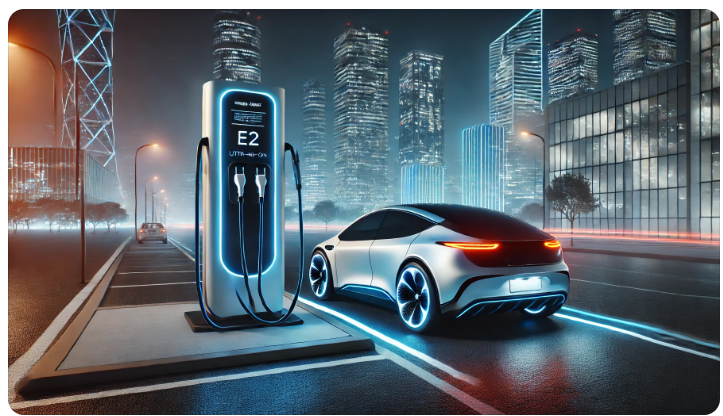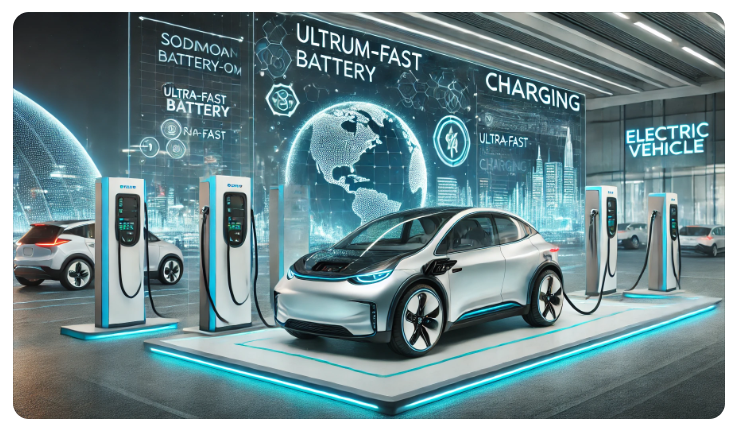New Sodium-ion battery technology could revolutionize EV charging by enabling ultra-fast charge times, possibly within seconds.
As electric vehicles (EVs) continue to reshape transportation, one critical factor stands in the way of their widespread adoption: charging time. Fast charging is pivotal for EVs to compete with the convenience of traditional gasoline-powered vehicles. However, lithium-ion batteries, the current industry standard, have limitations in terms of speed, capacity, and sustainability.
Enter sodium-ion batteries, a promising new technology that could revolutionize EV charging by enabling ultra-fast charge times, possibly within seconds. This article explores the science behind sodium-ion batteries, their potential benefits, and what this means for the future of electric vehicles.

Why Sodium-Ion Batteries?
Lithium-ion batteries have dominated the EV market due to their relatively high energy density, reliability, and capacity for multiple charging cycles. However, lithium resources are limited, and mining lithium is energy-intensive, costly, and environmentally taxing. Moreover, lithium-ion batteries pose challenges regarding thermal management and safety, especially when it comes to fast charging.
Sodium-ion technology offers a sustainable, cost-effective, and highly promising alternative. Sodium is more abundant and widely available, and sodium-ion batteries show resilience under high temperatures, which means they are safer and more adaptable for fast charging. Scientists have been researching sodium-ion batteries for years, and recent advancements are bringing this technology closer to becoming a viable replacement for lithium in EVs.
How Sodium-Ion Batteries Work
Sodium-ion batteries work similarly to lithium-ion batteries. During the charging and discharging process, ions move between the battery’s anode and cathode through an electrolyte solution. However, instead of using lithium ions, sodium-ion batteries use sodium ions.
One of the biggest challenges has been that sodium ions are larger than lithium ions, which complicates the design of high-energy-density batteries. To address this, researchers have been exploring innovative materials for sodium-ion battery electrodes and electrolytes. Among the promising materials is a new type of carbon anode, which can accommodate the larger sodium ions and has shown impressive performance in tests.
The most recent breakthroughs have focused on increasing energy density and cycle life while enhancing the charging speed of sodium-ion batteries. With these improvements, sodium-ion batteries are now emerging as a serious contender for EV applications, promising fast charging times without sacrificing capacity.
Ultra-Fast Charging in Seconds
One of the standout features of sodium-ion technology is its potential for ultra-fast charging. Researchers are achieving breakthroughs in the material science of sodium-ion batteries, pushing them to charge up to 10 times faster than lithium-ion batteries. Under laboratory conditions, some prototypes have achieved charging times as short as a few seconds.
The reason for this speed lies in the nature of sodium itself. Sodium ions tend to diffuse more quickly through the battery’s electrolyte and electrode materials than lithium ions. Additionally, the larger ionic radius of sodium helps the ions move quickly without causing structural stress on the electrodes, reducing the risk of overheating. Combined with advances in battery cooling systems, sodium-ion technology could become the backbone of fast-charging stations capable of fully recharging EVs in seconds.

Advantages of Sodium-Ion Batteries for EVs
- Reduced Charging Times: Sodium-ion technology’s most significant advantage is the potential for super-fast charging. A full recharge in seconds would redefine the EV experience, removing the need for prolonged charging stops and making EVs a true competitor to gasoline vehicles in terms of convenience.
- Cost-Effectiveness: Sodium is far more abundant than lithium, and sodium-ion batteries don’t require cobalt or nickel, two metals commonly used in lithium-ion batteries and known for their high costs and limited availability. This makes sodium-ion batteries cheaper to produce, which could lead to more affordable EVs for consumers.
- Environmental Benefits: The production of sodium-ion batteries has a lower environmental impact compared to lithium-ion batteries. The extraction and refinement of lithium are resource-intensive and can be harmful to the environment, while sodium is easier to mine and more widely distributed globally.
- Improved Safety: Sodium-ion batteries are generally safer than lithium-ion alternatives. They are more stable at high temperatures and less prone to overheating, which reduces the risk of thermal runaway—a condition that can lead to fires in lithium-ion batteries, especially during fast charging.
- Scalability and Abundance: With sodium being more accessible, the shift to sodium-ion batteries would reduce dependence on lithium-producing countries, allowing EV manufacturers more flexibility in sourcing materials and scaling up production.
Real-World Applications and Future Prospects of Sodium-ion Battery Technology
The sodium-ion battery is not yet commercially viable, but recent advances have brought it closer to market readiness. Some battery manufacturers and automakers have already started collaborating to pilot sodium-ion battery applications in EVs. With continued research, sodium-ion batteries could be available in EVs within the next decade.
The implications of ultra-fast charging are tremendous for both consumers and infrastructure. Imagine EV charging stations designed to deliver ultra-fast charges, similar to filling up a tank of gasoline. Instead of the traditional charging stations we see today, future stations could have ultra-high-power sodium-ion chargers that can deliver a full charge in seconds. This would make EVs more convenient than ever and drastically reduce wait times.
Challenges and the Road Ahead
Despite the benefits, sodium-ion batteries face certain challenges. For one, sodium-ion batteries still have a lower energy density compared to lithium-ion batteries, meaning they can’t store as much energy in the same volume. This could limit the range of EVs powered by sodium-ion batteries unless researchers continue making strides in improving density.
Moreover, sodium-ion technology is still in the experimental stage and has yet to be mass-produced at a scale that meets industry demands. Manufacturing processes will need optimization, and investment in production facilities is essential for sodium-ion batteries to become mainstream.
Nonetheless, with dedicated research, investment, and innovation, sodium-ion technology holds the promise of transforming the EV landscape, especially as fast charging becomes a focal point in EV adoption.
Conclusion: A Fast-Charging, Sustainable Future for EVs
Sodium-ion batteries represent an exciting breakthrough in battery technology, addressing many of the issues that have limited EV adoption thus far. With ultra-fast charging, lower costs, and greater environmental benefits, these batteries could pave the way for a new era of EVs that charge in seconds, not hours.
As the technology matures, sodium-ion batteries may offer the most sustainable and convenient solution for future EVs, transforming how we think about electric transportation. This future holds incredible promise: a world where EVs are not only accessible and eco-friendly but also effortlessly convenient.